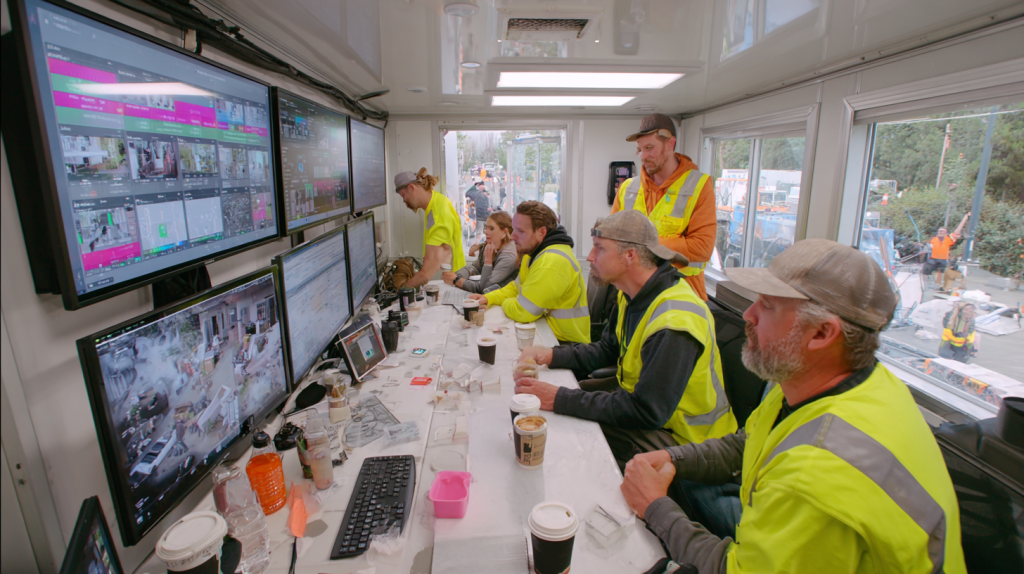Top Strategies Superintendents and Contractors Use to Keep Mission-Critical Data Center Projects on Schedule
Table of Contents:

Top Strategies Superintendents and Contractors Use to Keep Mission-Critical Data Center Projects on Schedule
Mission-critical data centers operate under one uncompromising rule—downtime is not an option. From hyperscale facilities to enterprise-grade server farms, every construction milestone must hit its mark precisely. For superintendents and contractors, keeping these projects on schedule requires more than hard work; it demands precision planning, coordinated communication, and technology that adapts as quickly as the project itself.
Unlike standard commercial construction, data centers depend on exact timing across dozens of specialized trades—mechanical, electrical, cooling, and IT infrastructure. A single missed delivery or delay in system commissioning can cascade into costly penalties or lost service uptime. To prevent that, project leaders rely on detailed scheduling systems, real-time coordination tools, and proactive decision-making that aligns every trade toward a common goal: seamless execution.
In this article, we’ll explore the top strategies superintendents and contractors use to keep mission-critical data center projects on schedule. You’ll learn how they manage overlapping scopes, integrate predictive scheduling tools, and maintain clear visibility across teams. We’ll also cover how platforms like StruxHub Construction Management Software help synchronize logistics, communication, and progress tracking—so every part of the project moves forward without missing a beat.
Prioritizing Early Planning and Scope Alignment
Data center schedules start before the first shovel hits the ground. Successful contractors and superintendents know that early coordination prevents future conflict. During preconstruction, they bring key stakeholders—mechanical, electrical, fire protection, and security teams—into detailed scope alignment meetings. This ensures everyone understands how their systems interconnect and what dependencies exist between tasks.
At this stage, defining long-lead procurement items is essential. Equipment like switchgear, generators, and UPS systems often have extended manufacturing timelines. By locking these in early, teams prevent critical path disruptions later. Early alignment also sets expectations for milestone tracking and communication frequency, giving owners confidence in the schedule’s reliability.
H3 Top Benefits
- Prevents rework and scheduling conflicts between trades
- Reduces procurement risk from long-lead equipment
- Builds stronger collaboration and schedule accountability
H3 Best Practices
- Conduct cross-trade coordination meetings during preconstruction
- Identify and track long-lead items early using digital dashboards
- Develop a phased milestone chart before mobilization
H3 Q&A Mini-FAQ
Q: Why is early planning more critical for data centers than other projects?
A: Because mechanical and electrical systems are deeply interdependent—delays in one trade affect them all.
Q: What’s the biggest scheduling risk early on?
A: Late procurement or misaligned scopes between specialized subcontractors.
Q: How can digital tools help with early planning?
A: Platforms like StruxHub allow teams to visualize milestones, dependencies, and delivery timelines from the start.
Early coordination lays the foundation for reliability. When every trade begins with a shared understanding of schedule priorities, the rest of the project can progress with precision and confidence.

Integrating Real-Time Scheduling Tools and Predictive Dashboards
Static schedules don’t work in the world of data centers. Timelines evolve by the hour, and waiting until the next meeting to update progress can mean lost time and money. To solve this, superintendents and contractors now rely on predictive scheduling dashboards that track progress in real time.
These dashboards integrate field data—delivery logs, manpower reports, and inspection results—directly into the master schedule. When a task slips, the system recalculates dependencies instantly, showing the impact across trades. This transparency allows teams to adjust workloads or resources before issues become crises. AI-assisted scheduling tools even forecast potential delays, helping supers make proactive decisions rather than reactive ones.
H3 Top Benefits
- Keeps schedules accurate and continuously updated
- Provides early warning of potential delays or resource gaps
- Improves communication between field teams and project managers
H3 Best Practices
- Sync dashboards daily with field reporting tools
- Use predictive analytics to forecast manpower or material shortages
- Review live dashboards in coordination meetings to align decisions
H3 Q&A Mini-FAQ
Q: What’s the advantage of predictive dashboards over traditional Gantt charts?
A: They connect live data from the field to scheduling logic, enabling instant updates.
Q: Can these tools track multiple project phases at once?
A: Yes—StruxHub’s scheduling engine visualizes overlapping phases across all trades and timelines.
Q: How do predictive analytics help prevent downtime?
A: They alert teams before a delay occurs, allowing adjustments to manpower or resources immediately.
By using real-time dashboards instead of static spreadsheets, project leaders gain the ability to react instantly—keeping mission-critical builds on pace no matter how complex they become.

Enhancing Trade Coordination and Communication Flow
On data center builds, every trade depends on another—mechanical follows structural steel, electrical follows mechanical, and commissioning can’t begin until every system passes inspection. To prevent cascading delays, communication between trades must be constant and structured.
Modern superintendents use shared coordination platforms where crews can view updated drawings, RFIs, and work zone maps in one place. Instead of relying on email chains or walkie-talkies, these platforms centralize communication and issue tracking. This reduces confusion and ensures decisions are documented in real time.
Regular stand-up meetings supported by digital dashboards further streamline coordination. Everyone knows the status of dependencies before work starts each day, preventing overlap and confusion.
H3 Top Benefits
- Strengthens collaboration and accountability between trades
- Reduces conflicts by sharing live drawings and progress data
- Speeds up decision-making with centralized communication
H3 Best Practices
- Hold daily coordination meetings with all lead foremen
- Use shared dashboards to visualize active zones and task dependencies
- Log all schedule adjustments and issue resolutions in one system
H3 Q&A Mini-FAQ
Q: How do CLP dashboards support trade coordination?
A: They show logistics, crew assignments, and equipment locations—keeping trades informed on site conditions.
Q: Should trade leads have dashboard access?
A: Yes—shared visibility keeps everyone aligned and accountable.
Q: How often should teams sync communication updates?
A: At least once daily, but ideally in real time through integrated tools like StruxHub.
When communication becomes a structured, documented process, coordination across trades shifts from reactive firefighting to seamless collaboration—exactly what mission-critical projects demand.

StruxHub
Experience the power of StruxHub today and witness firsthand how it can revolutionize your construction operations.
Sequencing Logistics and Material Deliveries with Precision
In data center construction, materials don’t just arrive—they’re orchestrated. With thousands of components ranging from steel framing to fiber cabling, logistics sequencing becomes as critical as scheduling itself. The goal is to ensure that every delivery arrives exactly when needed, without overwhelming limited laydown areas or blocking critical paths.
Superintendents use detailed logistics plans that map when and where materials should be delivered. Digital tools like StruxHub automate this process, aligning delivery schedules with project milestones and crew activity. This ensures materials are staged efficiently and ready for installation without slowing progress. For contractors, precise sequencing prevents costly rework, idle labor, and storage congestion—keeping the entire operation synchronized.
H3 Top Benefits
- Prevents delivery conflicts and material congestion
- Aligns logistics with installation timelines for smoother workflow
- Reduces downtime caused by delayed or misplaced deliveries
H3 Best Practices
- Integrate delivery scheduling with the master construction schedule
- Assign logistics coordinators to monitor gate flow and staging areas
- Use digital dashboards to track incoming shipments and delivery timing
H3 Q&A Mini-FAQ
Q: Why is sequencing logistics so important for data centers?
A: Every trade relies on just-in-time materials—late or early deliveries can cause major schedule impacts.
Q: Can digital CLPs automate delivery coordination?
A: Yes—tools like StruxHub automatically assign delivery windows and notify crews in real time.
Q: What’s the biggest cause of logistics delays?
A: Lack of visibility across suppliers and overlapping delivery requests.
Efficient logistics sequencing keeps every part of a data center project moving like clockwork—ensuring materials, manpower, and machinery arrive exactly when they’re needed.
Managing Risk and Change Through Real-Time Updates
Even with the best planning, mission-critical projects evolve daily. Weather, supply chain issues, and last-minute design changes can shift schedules in an instant. The key to staying on track is maintaining constant visibility and adapting fast. Real-time reporting tools allow superintendents to log changes immediately, updating schedules and forecasts across every team.
Contractors use predictive risk modeling to identify where delays are likely to occur before they happen. If a generator shipment is late or a vendor misses a milestone, the system recalculates timelines and redistributes manpower automatically. This flexibility is what separates successful data center teams from those playing catch-up.
H3 Top Benefits
- Detects potential delays before they impact project milestones
- Provides early warnings through live field data integration
- Enhances accountability by tracking all changes in one system
H3 Best Practices
- Update schedule dashboards daily with real field inputs
- Assign clear responsibility for issue tracking and resolution
- Use predictive analytics to evaluate schedule impact in real time
H3 Q&A Mini-FAQ
Q: How does predictive risk modeling help maintain schedules?
A: It identifies early warning signs—like procurement delays—before they affect downstream tasks.
Q: Who should manage schedule changes in real time?
A: Superintendents update the field data; project managers verify impacts and mitigation actions.
Q: What’s the benefit of digital versus manual risk tracking?
A: Digital tools connect risks to schedule data instantly, ensuring corrective actions are timely and accurate.
The ability to react instantly to shifting field conditions is what keeps complex, fast-track projects running smoothly—and what owners expect from mission-critical teams.
Leveraging Data and Automation to Keep Teams Aligned
Data is the new foundation of construction efficiency. On mission-critical data center projects, automation transforms data into actionable insights—helping superintendents and contractors maintain precision without manual oversight. By integrating automation into logistics, scheduling, and reporting, teams ensure that every update is captured and every stakeholder remains informed.
AI-driven platforms like StruxHub analyze manpower, progress photos, and sensor data from the field to provide daily performance summaries. These analytics highlight where resources are over- or under-utilized, allowing managers to rebalance before productivity drops. Over time, the data also strengthens future project planning, identifying patterns that improve accuracy for the next build.
H3 Top Benefits
- Keeps all teams synchronized through live, automated updates
- Reduces manual entry and communication errors
- Generates actionable insights for future project forecasting
H3 Best Practices
- Automate daily progress tracking and logistics reports
- Review AI analytics weekly to identify recurring bottlenecks
- Share key performance dashboards with all major stakeholders
H3 Q&A Mini-FAQ
Q: How does automation improve schedule reliability?
A: It eliminates human error by capturing updates instantly from the field.
Q: Can data analytics improve long-term project performance?
A: Yes—AI identifies trends that inform better resource allocation and scheduling in future builds.
Q: How does StruxHub use automation?
A: It synchronizes field inputs, delivery logs, and schedules into one connected platform for real-time oversight.
Automation brings data center project management into the modern era—turning constant coordination into an intelligent, self-adjusting process.
Related Pillar Articles:
Best Guide to Construction Logistics Plans (CLPs): What Owners Want to See Before Work Starts
StruxHub
Discover how StruxHub can revolutionize your construction management. Contact us today!
How StruxHub Keeps Mission-Critical Projects on Schedule
StruxHub simplifies the complexity of mission-critical data center projects by connecting logistics, scheduling, and reporting into one integrated system. Superintendents can manage daily operations, deliveries, and manpower from a single dashboard, while predictive analytics forecast potential schedule conflicts before they occur.
The platform’s automation tools synchronize real-time field updates, ensuring every stakeholder—from subcontractors to owners—has instant visibility into progress and logistics status. AI-driven scheduling recommendations help teams reallocate resources dynamically, keeping all trades aligned and milestones intact.
For contractors managing multiple facilities or hyperscale sites, StruxHub’s centralized data model creates consistency across projects—turning fragmented processes into a unified, data-driven ecosystem.
H3 Top Benefits
- Combines scheduling, logistics, and communication in one platform
- Predicts and resolves schedule conflicts automatically
- Provides owners and teams with transparent, real-time progress tracking
H3 Best Practices
- Use StruxHub’s predictive tools to manage overlapping trades
- Review dashboard updates daily for quick adjustments
- Integrate logistics planning early during preconstruction for better scheduling control
H3 Q&A Mini-FAQ
Q: Can StruxHub manage multiple mission-critical sites simultaneously?
A: Yes—it allows contractors to oversee multiple builds under one unified dashboard.
Q: How does StruxHub help maintain project transparency?
A: All schedule changes and logistics updates are instantly shared with stakeholders in real time.
Q: What kind of reporting does StruxHub generate?
A: The system produces automated daily summaries and predictive performance reports that track progress across all project phases.
StruxHub gives superintendents and contractors the digital infrastructure they need to deliver complex, mission-critical projects—on time, on budget, and without downtime.

FAQ
Why are mission-critical data center schedules so challenging to manage?
Data centers involve complex systems—electrical, cooling, IT, and security—all built in overlapping sequences. Every component must function perfectly together, so scheduling conflicts can have exponential ripple effects. Maintaining precision and real-time coordination across trades is essential to meet strict commissioning deadlines and uptime guarantees.
What strategies help superintendents keep data center projects on schedule?
The most successful teams rely on predictive scheduling, proactive logistics sequencing, and clear trade communication. Daily coordination meetings backed by real-time dashboards ensure all activities stay aligned. Automated tools like StruxHub make these updates seamless, keeping the entire project synchronized from procurement to commissioning.
How does automation improve data center construction performance?
Automation removes manual bottlenecks by connecting field updates directly to scheduling tools. It allows instant visibility into delivery delays, manpower shifts, and equipment usage. With automated reporting, superintendents spend less time on paperwork and more time managing the field—keeping performance metrics consistent and measurable.
What role does logistics play in staying on schedule?
Efficient logistics ensure that materials, machinery, and personnel flow smoothly without interruptions. Coordinating deliveries and access routes prevents gate congestion and keeps installation sequences on track. Tools like StruxHub integrate CLPs directly with schedules, allowing teams to anticipate and prevent potential slowdowns.
How does StruxHub support mission-critical data center teams?
StruxHub consolidates every aspect of data center coordination—scheduling, logistics, safety, and analytics—into one platform. Its predictive algorithms detect risks early, and its real-time dashboards give superintendents complete visibility into progress. By combining automation and communication, StruxHub helps contractors deliver high-performance facilities on time and at the highest quality standards.




